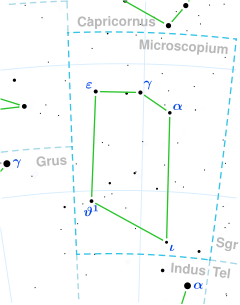Star in the constellation Microscopium
Epsilon Microscopii , Latinized from ε Microscopii, is a single,[ 10] star in the southern constellationof Microscopium . It is faintly visible to the naked eye with an apparent visual magnitude of 4.71.[ 1] parallax shift of the star is 19.7054 mas [ 2] light years . It is moving further from the Sun with a radial velocity of +7 km/s.[ 5]
This star has a stellar classification of A1 V,[ 3] A-type main-sequence star that is generating energy through hydrogen fusion at its core . The stellar spectrum displays an overabundance of silicon in the star's atmosphere ,[ 11] [ 9] mass of the Sun and 2.2 times the Sun's radius .[ 7] [ 8] projected rotational velocity of 127 km/s.[ 3] Sun's luminosity [ 1] photosphere at an effective temperature of 9,126 K.[ 8]
Epsilon Microscopii was a latter designation of the star 4 Piscis Austrini .[ 12]
This star was the brightest star in the obsolete constellation Globus Aerostaticus .[ 13]
References
^ a b c d e f Anderson, E.; Francis, Ch. (2012). "XHIP: An extended hipparcos compilation". Astronomy Letters 38 (5): 331. arXiv :1108.4971 Bibcode :2012AstL...38..331A . doi :10.1134/S1063773712050015 . XHIP record for this object at VizieR .^ a b c d e Van Leeuwen, F. (2007). "Validation of the new Hipparcos reduction". Astronomy and Astrophysics . 474 (2): 653– 664. arXiv :0708.1752 Bibcode :2007A&A...474..653V . doi :10.1051/0004-6361:20078357 . S2CID 18759600 . Vizier catalog entry ^ a b c d Hoffleit, D.; Warren, W. H. (1995). "VizieR Online Data Catalog: Bright Star Catalogue, 5th Revised Ed. (Hoffleit+, 1991)". VizieR On-line Data Catalog: V/50. Originally Published in: 1964BS....C......0H . 5050 . Bibcode :1995yCat.5050....0H . ^ a b Mallama, A. (2014). "Sloan Magnitudes for the Brightest Stars". The Journal of the American Association of Variable Star Observers . 42 (2): 443. Bibcode :2014JAVSO..42..443M . Vizier catalog entry ^ a b Gontcharov, G. A. (2006). "Pulkovo Compilation of Radial Velocities for 35 495 Hipparcos stars in a common system". Astronomy Letters . 32 (11): 759– 771. arXiv :1606.08053 Bibcode :2006AstL...32..759G . doi :10.1134/S1063773706110065 . S2CID 119231169 . ^ Brown, A. G. A. ; et al. (Gaia collaboration ) (August 2018). "Gaia Data Release 2: Summary of the contents and survey properties" . Astronomy & Astrophysics 616 . A1. arXiv :1804.09365 Bibcode :2018A&A...616A...1G doi :10.1051/0004-6361/201833051 Gaia DR2 record for this source at VizieR .^ a b c Allende Prieto, C.; Lambert, D. L. (1999). "Fundamental parameters of nearby stars from the comparison with evolutionary calculations: Masses, radii and effective temperatures". Astronomy and Astrophysics . 352 : 555– 562. arXiv :astro-ph/9911002 Bibcode :1999A&A...352..555A . Vizier catalog entry ^ a b c d e David, Trevor J.; Hillenbrand, Lynne A. (2015). "The Ages of Early-Type Stars: Strömgren Photometric Methods Calibrated, Validated, Tested, and Applied to Hosts and Prospective Hosts of Directly Imaged Exoplanets". The Astrophysical Journal . 804 (2): 146. arXiv :1501.03154 Bibcode :2015ApJ...804..146D . doi :10.1088/0004-637X/804/2/146 . S2CID 33401607 . Vizier catalog entry ^ a b Gontcharov, G. A. (2012). "Dependence of kinematics on the age of stars in the solar neighborhood". Astronomy Letters . 38 (12): 771– 782. arXiv :1606.08814 Bibcode :2012AstL...38..771G . doi :10.1134/S1063773712120031 . S2CID 118345778 . Vizier catalog entry ^ Eggleton, P. P.; Tokovinin, A. A. (September 2008). "A catalogue of multiplicity among bright stellar systems" . Monthly Notices of the Royal Astronomical Society . 389 (2): 869– 879. arXiv :0806.2878 Bibcode :2008MNRAS.389..869E . doi :10.1111/j.1365-2966.2008.13596.x S2CID 14878976 . ^ Renson, P.; Manfroid, J. (May 2009), "Catalogue of Ap, HgMn and Am stars" , Astronomy and Astrophysics , 498 (3): 961– 966, Bibcode :2009A&A...498..961R , doi :10.1051/0004-6361/200810788 ^ Wagman, M. (August 1987). "Flamsteed's Missing Stars". Journal for the History of Astronomy . 18 (3): 220. Bibcode :1987JHA....18..209W . doi :10.1177/002182868701800305 . S2CID 118445625 . ^ Ian Ridpath's Star Tales - Globus Aerostaticus














